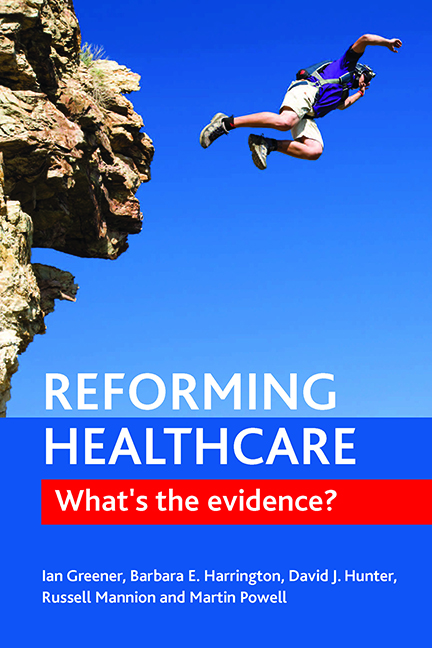Book contents
- Frontmatter
- Contents
- List of tables
- Acknowledgements
- one Introduction
- two The NHS in 1990
- three Reorganising the NHS, 1990–2010
- four ‘Central control’ reorganisation in the NHS in the 2000s
- five Local dynamic reform in the NHS since 2000
- six The prospects for NHS reorganisation post-2010
- seven Conclusion
- References
- Index
four - ‘Central control’ reorganisation in the NHS in the 2000s
Published online by Cambridge University Press: 25 February 2022
- Frontmatter
- Contents
- List of tables
- Acknowledgements
- one Introduction
- two The NHS in 1990
- three Reorganising the NHS, 1990–2010
- four ‘Central control’ reorganisation in the NHS in the 2000s
- five Local dynamic reform in the NHS since 2000
- six The prospects for NHS reorganisation post-2010
- seven Conclusion
- References
- Index
Summary
The context of health policy in the 2000s
Attempting to reorganise the NHS so that there is a stronger means of managing the performance of healthcare organisations is not a new idea. Performance indicators were first introduced in the 1970s and were extended during the 1980s, with the first comprehensive national performance data set disseminated in September 1983 to local health authorities in a series of ‘grey books’ (Pollitt, 1985). In 1991, and marking the creation of the internal market, these performance indicators were relabelled health service indicators. By the end of the decade their use was still largely an ‘external’ exercise where ratings were published once a year and league tables constructed, apparently mostly with the public (or at least the media) as their intended audience, but with few penalties for NHS trusts rated as the worst performers, and few rewards for those graded as performing well.
This chapter considers how Labout put in place a series of organisational changes based around the goal of achieving greater ‘central control’ over implementation (or ‘delivery’, as it became known) during the 2000s. It considers the use of performance management systems in both hospitals and GP surgeries, but with, we will argue, very important differences that affected the relative successes of such systems in those different contexts. Because the context here has already been outlined to some extent in Chapter Three, there is necessarily some repetition in order both to be clear about the policy environment of the 2000s, but also to try and make each chapter as free-standing as possible in terms of content. We hope that presenting the material in this way adds to clarity without putting readers off.
As noted in Chapter Three, there were signs from 1997 and 1998 that Labour wanted to tighten central control over policy implementation, but it was not until the publication of the NHS Plan in 2000 (Secretary of State for Health, 2000) that the new direction became fixed. The NHS Plan marked the beginning of a period of increased investment in the NHS, raising the proportion of gross domestic product (GDP) spent on healthcare in the UK to around the European Union (EU) average from being around 2 percentage points below.
- Type
- Chapter
- Information
- Reforming HealthcareWhat's the Evidence?, pp. 53 - 82Publisher: Bristol University PressPrint publication year: 2014



